
views
- Set your blocks so the front pedal is 2–2 1⁄4 feet (0.61–0.69 m) from the starting line and the back pedal is 3–3 1⁄4 feet (0.91–0.99 m) from the starting line.
- Once the starter pistol goes off, stay low and pump your arms hard for the first 10 meters before slowly coming upright around the 20-meter mark.
- Focus on your breath control and posture while you settle your sprint into a more relaxed run to conserve your energy.
Getting Set
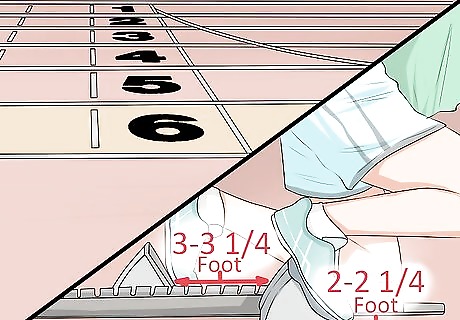
Set your blocks. Find your assigned lane and use the length of your feet to gauge where to place the blocks. The tip of the unit should measure about a foot length from the starting line.The front pedal should be 2 to 2 1/4 foot lengths from the starting line. The back pedal should be 3 to 3 1/4 foot lengths from the line. Your lead foot is your stronger foot. Go with whichever foot you'd use to kick a soccer ball. Since the standard track lap is 400m, a 200m dash is half a lap, so you'll be starting on a curve. Runners set themselves on diagonally staggered start lines to compensate for the differences in distance between the first and last lanes. For beginners, or if you’re just running a dash in gym class, it’s not necessary to use starting blocks. However, if you plan on running sprints competitively, you should get used to using them.
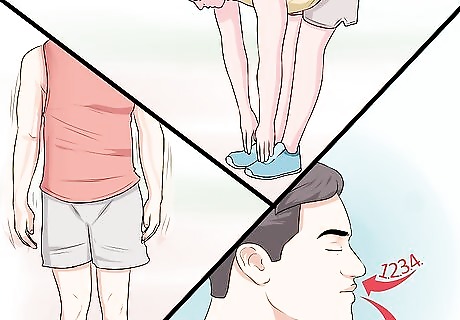
Do your ritual. Generally, the four commands are stand in your lanes, runners to your marks, set, and then the gun. Before hearing the signals to get set and go, you’ll be told to get in your lane. Now’s your chance to stretch, do your pre-race ritual, and get your mind set for a good race. Even the best get nervous just before the race, so now’s the time to get those jitters out. Try bending over and touching your toes to stretch the back of your legs. Stretch your quads by lifting each leg backward from the knee while standing straight and reaching back to hold your foot. Shake out your arms and legs to get blood flowing. Breathe deeply, counting to four, holding for a four count, then exhaling as you count to four. You don't want to relax too much or make yourself sleepy, but should get your mind locked on the race itself as you fill your body with oxygen. Focus your vision by staring at the track, and get the crowd, other racers, and any other distractions out of your field of vision. Concentrate only on the race, and imagine how you'll burst from your starting blocks, speed down the track, and make a great time.
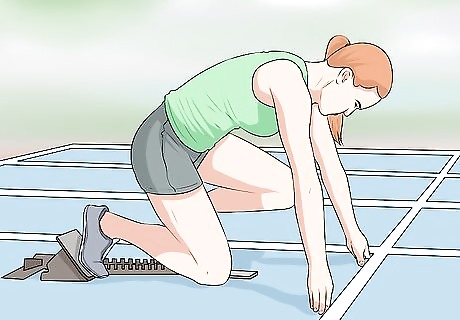
Get in your first position. When you’re told to get to your mark, get in your blocks, clear your mind, and prepare to listen for the gun. Comfortably put yourself in a crouching position with your back knee on the ground and your weight resting on your fingertips. Hold your fingertips just inside your starting line and position your body so your shoulders are directly above your hands. If you're using blocks, make sure your lead toe is off the ground and completely in the blocks. If you're not using starting blocks, you can still use a crouching start. Position your front toe so it's a foot length back from the starting line. Get yourself in the same coiled position with your fingers flanking the line.

Listen for the set command. When you hear the set command, raise your hips and rear end. Put your body in a loaded position, ready to spring from the blocks. Your legs should be ready to fire as soon as you hear the gun, or go command. Keep your back and your waist aligned in a straight line in order to get the best take-off. Slowly inhale and fill your lung capacity during your set.
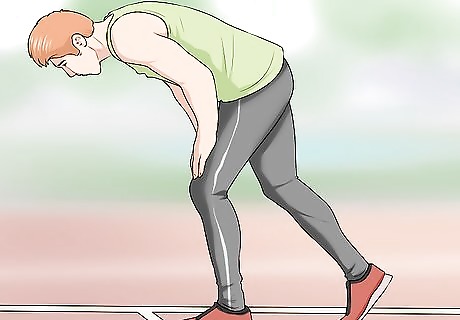
Consider using a standing start. Although many meetings require blocks for dashes, you could skip the blocks and use a standing start if you're not racing competitively or if blocks are not required. Position your lead foot one length back from the starting line, and line up your rear foot's toes with your lead heel. Feet should be shoulder length apart, and you should be slightly crouched so your weight rests on the balls of your feet. Your knees should be slightly bent. When you hear the start command, swing the arm opposite your lead leg forward as you lift your rear foot. Propel yourself forward using your lead leg. Lean forward into long, powerful strides to accelerate into a sprint.
Starting Strong

Listen for the “B” of the “Bang.” This runner’s mantra warns against starting too late into the bang of the gun. Explode from the blocks as soon as you hear the bang. Reaction time is vital to any race, and is especially important to sprints, which are often decided by mere milliseconds. You might hear a second shot from the gun. This signals someone has false started, so runners must return to their starting spots.

Breathe every 10 to 15 meters. Try to take deep breaths at regular intervals to avoid cramping and to maintain a good rhythm. If you feel like to need to take a breath, then take one. The most important breath you take is the one during your set position: it’ll oxygenate your body and help you focus. Although it’s certainly not advisable, for some short-distance races, some of the greats barely even breathed at all.
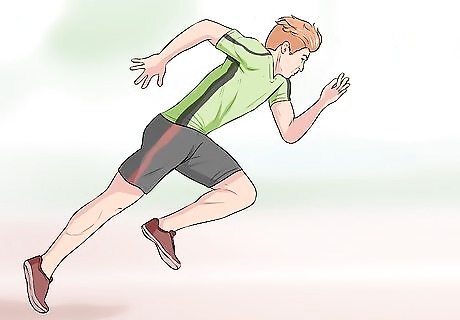
Stay low. Fire out low from the blocks and stay low for the first 10 meters: you should not be running upright, but leaning slightly forward. Keep your eyes trained toward the ground. Pump your legs hard and use your arms to power your acceleration.
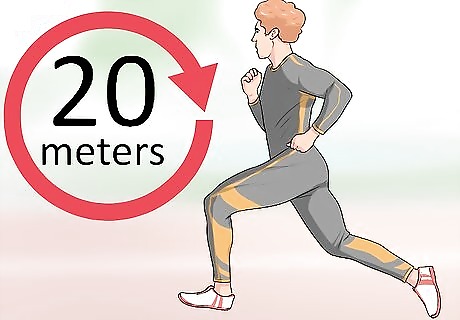
Bring your body upright. As you approach the 20-meter mark, begin to come into an upright position. You should be completely upright at 20 meters as you shift from accelerating to full speed running. By the time you reach 30 meters, you should be running at your maximum speed.
Finishing the Race

Nail the turn. Since you’re starting on a curve, you’ve got to hug the inside of your lane to maximize acceleration. Aggressively lean into the inside of your lane in order to take advantage of your centripetal force. Once you come out of the curve and into the straightaway, get your upper body back into its straight and upright form. Different lanes have different curve angles. Lane one has one of the tightest turns, while lanes seven and eight have very wide turns. Many runners will try to get to the center lanes, where turns are most manageable, but taller runners tend to do well on the outside lanes, where the turn radius is widest.

Relax your run. After accelerating powerfully and getting to full speed around 30 meters, keep tall and relax your sprint as you approach the finish. Relaxing your sprint doesn't mean slow down: you’ll still be all-out sprinting. You do, however, want to maintain full speed by concentrating on good running form to waste the least amount of energy: Be sure to keep pumping your arms. Your hands should reach up to your eye level. Try to run on the balls of your feet.

Lean forward into your finish. Leaning can mean the difference between 1st and 2nd place in a short-distance race. Most 200 meter dashes are won or lost by a small fraction of a second. As you approach the finish line, speed up and lean slightly forward, making sure you run through the line by imagining your finishing point is beyond the line itself.
Improving Performance
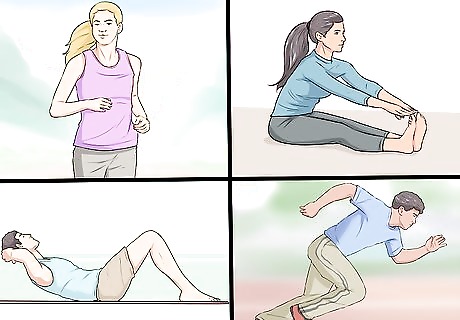
Take on a conditioning regimen. If you’re in a gym class or on the track team, your coach will make sure you’re conditioning yourself properly. However, if you’re working on your speed and endurance on your own, you’ll have to design your own drills to get yourself into the best shape. There are plenty of resources available through an internet search, but some basic drills include: Warm up with 2 to 5 minutes of light jogging and a core exercise like crunches, run six to eight 200 meter dashes at 75% effort, cool down with a 2 to 5 minute light jog and leg stretches. Good stretches include sitting with your legs in front of you while reaching for your toes, and holding the soles of your feet together with your knees bent in a butterfly stretch. Sprint drills: warm up with 10 minutes of jogging, then alternate 100 meters each of sprint, walk, jog. Rest for 3 minutes, then repeat this 100 meter sprint-walk-jog.

Practice by running longer distances. A 200 meter sprint is a speed endurance challenge, so you’ve got to build your aerobic endurance level if you’re going to succeed. If you’re running a 200 meter, practice by running 300 and 400 meter distances. Running longer distances will make shorter distances that much easier.
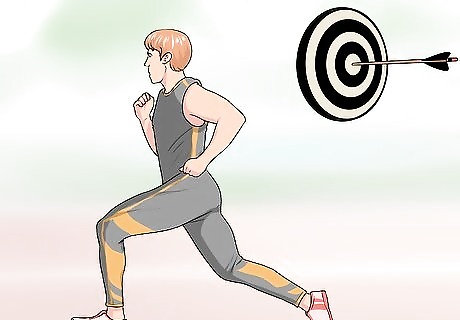
Keep your eye on the track. When you’re training, work on keeping your eyes on the track and finish line. Research shows that if you look around elsewhere for just a second, you slow down. Make your focus and concentration priorities during practice.


















Comments
0 comment